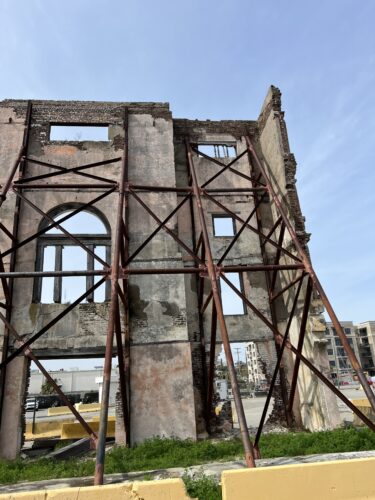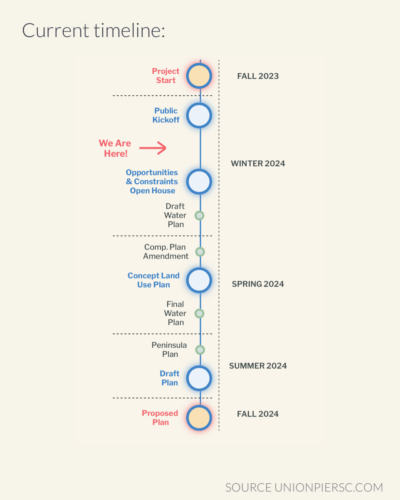 Menu
Menu
Posted: March 7, 2024

The Bennett Rice Mill from the interior, stabilization efforts are visible. March 5, 2024.
The Port and the Riley Center hosted an open house at the cruise terminal this week to engage with the community on the “opportunities and constraints” of the planned redevelopment of Union Pier and to provide tours around the property. Most Charlestonians are used to seeing the large expanse of asphalt from a car moving along Washington Street—from this vantage point it is difficult to get a true sense of the scale and potential of the site. It is also challenging to grasp the physical and technical complexity of inserting an entirely new neighborhood onto this industrial waterfront land. Several themed stations were set up to address the various aspects of Union Pier that are currently being considered by the master planners.
 There were several remarkable aspects of this open house that deserve attention because they deviate from the previous planning effort that imploded last June. First, the landscape architects had delved deep into the history of the site, from the pre-historical period to its time as a colonial port, industrial center, then international port facility. This acknowledgment of the layered history helps to ground any future approach to land use and development. Second, the team prepared in-depth analysis of the character and context of Charleston’s historic urban form and streets, indicating that they truly seek to make this plan a natural extension of the city to the water’s edge. Lastly, there was a fascinating array of research into the structural, environmental, and financial challenges with developing a complex site like this—almost half of which sits on aging piers out over the water. The underlying soil has been contaminated over many decades of industrial use, the site is low-lying and subject to severe flooding and storm surge, there is not much infrastructure currently on the property (therefore large investments required for water, sewer, utilities, roads/sidewalks), and the aggregate costs of addressing these issues for new development is daunting. Which get us to the penultimate question: what is this property worth and how can the owner and community determine a viable approach for funding this redevelopment without diluting the positive elements that people are seeking: generous parks and open space, properly scaled buildings, resiliency features, workforce housing, and public amenities?
There were several remarkable aspects of this open house that deserve attention because they deviate from the previous planning effort that imploded last June. First, the landscape architects had delved deep into the history of the site, from the pre-historical period to its time as a colonial port, industrial center, then international port facility. This acknowledgment of the layered history helps to ground any future approach to land use and development. Second, the team prepared in-depth analysis of the character and context of Charleston’s historic urban form and streets, indicating that they truly seek to make this plan a natural extension of the city to the water’s edge. Lastly, there was a fascinating array of research into the structural, environmental, and financial challenges with developing a complex site like this—almost half of which sits on aging piers out over the water. The underlying soil has been contaminated over many decades of industrial use, the site is low-lying and subject to severe flooding and storm surge, there is not much infrastructure currently on the property (therefore large investments required for water, sewer, utilities, roads/sidewalks), and the aggregate costs of addressing these issues for new development is daunting. Which get us to the penultimate question: what is this property worth and how can the owner and community determine a viable approach for funding this redevelopment without diluting the positive elements that people are seeking: generous parks and open space, properly scaled buildings, resiliency features, workforce housing, and public amenities?
This is the critical question that needs to be answered in the next couple of months before a master plan is presented for city approvals. All levels of government—from federal, state, county, and city—will need to be engaged to help answer this question. HCF will be at the center of these conversations and will continue to keep the community informed as the process unfolds.
To learn more about the project, visit the dedicated website: UnionPierSC.com
Agreed, the NEIGHBORHOOD, not a district, needs to be a natural extension of Ansonborough, the Market area, and the French Quarter with affordable housing infused into the plan. This will ensure an appropriate neighborhood and pedestrian scaled PLACE. I think the mix should 55% ‘built’ and 45% Open Space of the highground acres only; the Open Space over the OCRM Critical Line is a bonus!
The Open Space must be arranged in a manner to celebrate the sites, places, activities learned from the deep dive into the uses of the past. A large park from west to east with the ‘Rice Mill’ and a ‘wharf’ acting as book ends SHALL be the ‘central park’ of the neighborhood.
The ‘cost of the public realm’ should not be a factor; the well designed and detailed public realm is a ‘Gift to the People”.
The plan must require a couple of sites for civic buildings; a new church steeple would be a delight to someday view looking back at the development’s skyline while standing at the water’s edge.
The development must take an approach to ‘Design with Nature’. Charleston is special in part due to the wonderful pocket parks, civic parks, private gardens, street trees, and all the stuff that grows in between. Every rain drop counts and vegetation can take the lead in mitigating the rain bomb events.
Lastly, the words of a former Mayor must ring true, the PLACE must be a ‘World-Class’ urban infill project.
Excellent summary of where we are. I hope an early conclusion by the team is that buildings should be no higher than four floors even if the lower floor is used for parking to mitigate damage from possible flooding. Four floors means ‘low rise’ and nothing taller than the Bennett Rice Mill facade.
I am an avid cruiser and also have been a member of your organization for many years. I am very unhappy about the closure of the cruise terminal to Carnival. It appears that Charleston is speaking out both sides of the mouth that it wants tourists and freighters but not cruise travelers. As a South Carolinian we are a tourist state.
The site needs to honor the long past of the site, its former and current residents. Honoring the residents means those who occupy the city as residents, those who occupied the space in its history; the indigenous people, enslaved people, immigrants, laborers past and present. The natural contours and sensitivity to the natural environment should be tops of the list of priorities. As a society we have too long assumed that as humans we know best and, well, here we are. Building on wetlands, covering over the natural contours with concrete and rotting piers. We can do better than that. A “world-class” city does not mean an homage to man but a reverence and respect for the environment and design that is sensitive and acknowledges Charleston’s true past rather than the one that has too often suited political interests.